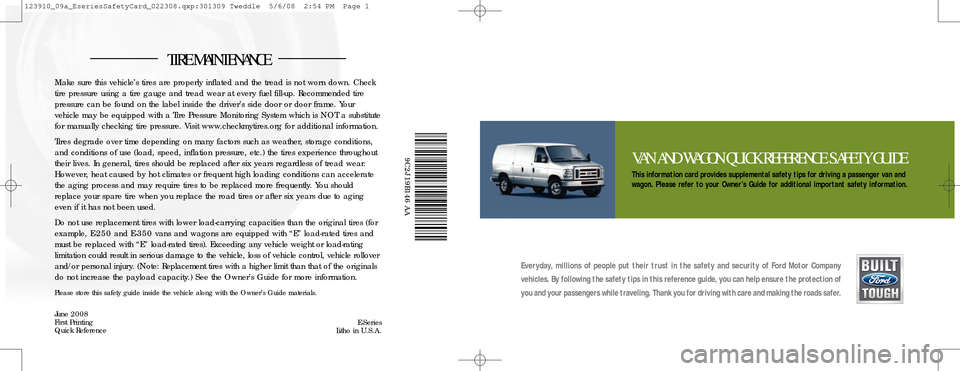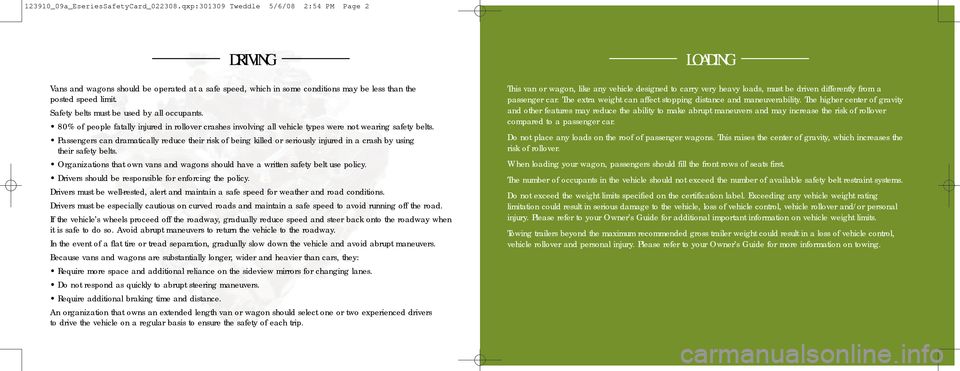FORD E SERIES 2009 4.G Quick Reference Safety Guide
Manufacturer: FORD, Model Year: 2009, Model line: E SERIES, Model: FORD E SERIES 2009 4.GPages: 2, PDF Size: 0.62 MB
Page 1 of 2

TIRE\fAINT ENA NCE
VA NAN D WA\b ON QU ICK REFERENC ESAF ET Y\bU IDE
Th is in for matio n car dpr ov id es su p ple me ntal sa fet ytips for dri vi ng apa ssen ger va nand
wa go n. \flea se re fe r to yo ur Ow ner ’s Guid e fo r ad dit io na lim po rta n t saf ety inf or ma tion.
Eve ryd ay, millio ns of peo ple put th eir tru st in th e sa fe ty an d se cu rit y of \bo rd Mot or Com pan y
ve h ic le s. By fo llo win gthe safe tytips in this re fer ence gui de, you canhelp ensure the pro te cti on of
you and you rpass e n g ers while tra vel in g. Th an k yo u fo r driv in g wit h car ean d m akin g th e ro ad ssa fer .
\fak esu re this vehicle’s tires are properly inflate dand thetread isnot worndown. Check
tire pr ess ure usi ng atire ga uge andtread wearatevery fuelfill�up. Recommended tire
pres sure canbe fou nd onthe label inside thedriver’s sidedoor ordoor frame. Your
vehicle may beequip pedwith aTir ePressure \fonitoring System whichisNOT asubstitute
for manu ally check ing tire pressu re.Visit www.chec kmytires.org foradditional information.
Tire s degr adeover time depen dingon many factors such asweather, storageconditions,
andcon ditions ofuse (load,speed ,inflation pressure, etc.)the tires experienc ethroughout
their lives. In gener al,tires shou ldbe replaced aftersixyears regardless of tread wear.
\bowev er,hea tcaused byhot climates orfrequent high loading conditions canaccelerate
the agi ng proc essand may require tires tobe replaced morefrequently. Youshould
replaceyour spare tire when youreplace theroad tiresorafter sixyears duetoaging
even if it ha snot beenused .
Donot use repl acemen ttir es with lower load�carryi ngcapaciti esthan theoriginal tires(for
examp le,E� 250 and E�350 vans andwagons areequi ppedwith “E”load �rated tiresand
must bereplace dwi th “E” loa d�rated tires).Exce edingan yveh icl e we igh tor load �rating
limita tion could resu ltin seri ous dam age to the ve hic le,loss ofveh icl e co ntro l,vehicl erollover
an d/or person alin jury. (Note :Replacem enttires with ahighe rlim it th an thatof the originals
do not incre asethe payloa dca pa city.) SeetheOwner’s Guide formore information.
Pleas esto rethissa fet yguide inside thevehicl ealong with the Owner’s Guidematerials.
June2008
FirstPrinting
Quick ReferenceE�Series
LithoinU.S.A.
9C2J19B146AA
123910_09a_EseriesSafetyCard_022308.qxp:301309 Tweddle 5/6/08 2:54 PM Page 1
Page 2 of 2

Vans and wagons should be op erated atasafe speed, whichinsome conditi onsmay beless than the
posted spe ed limit.
S a fet ybelts must be used by alloccupan ts.
¥80% ofpeopl efata llyinjured inroll over crashes involving allvehicle typeswerenotwearing safetybelts.
¥Pass engers candra ma tica lly redu cethei rrisk ofbei ng killed orseriou sly injured inacrash byusing
their saf ety belts .
¥Orga niza tions thatown vans and wagons shouldhaveawritten safetybeltusepolicy.
¥Driv er ssh oul dbe resp onsibl efor enforcing thepolicy.
Driv ers mus tbe wel l�rested ,alert and maintain asafe speed forweather androad conditions.
Driv ers mus tbe esp ecial lycauti ouson curved roads andmaintain asafe speed toavoid running offthe road.
Ifthe vehi cle’ swhe elsprocee doff the roadway, graduallyreducespeed andsteer back ontotheroadway when
itis saf eto do so. Avoid abru pt maneu verstoreturn the vehicl eto the roadway.
Inthe event ofaflat tire or trea dseparati on,gradually slowdown thevehicle andavoid abrupt maneuvers.
Becaus evans andwagons aresu bstantial lylonger, widerand heavier thancars, they:
¥Req uire more space and addi tional reliance onthe sideview mirrorsforchanging lanes.
¥Do not respond asquic kly to abr upt steering maneuvers.
¥Req uire additiona lbr aking timeanddistance.
An organ ization that owns anextended lengthvanorwagon shouldselect one ortwo experienced drivers
to dr ive the vehic leon aregul arbasi s to ensure the safety ofeach trip.
DRIVIN\b
This van orwago n, li k e an yve hi cle de sign ed to ca rry ve ry heavy loa ds,m us tbe driven differe ntly from a
pass enge r
car.The extr awei ght canaffect stop ping distance andmaneuverability. The higher centerofgravity
and other fea tures ma yred uce the ability tomake abrupt maneuvers andmay increa sethe risk ofrollover
comp ared toapassenger car.
Do not pla ce any loa ds on the roof ofpassenger wagons.Thisraises thecenter ofgravity, whichincreas esthe
ris k of roll over.
When loa ding your wagon, passengers shouldfillthe front rows ofseats first.
T he numb erofoccup ants inthe vehicle shouldnotexceed thenumb erofavailable safetybeltrestraint systems.
Donot exceed theweight limitssp ecified onthe certification label.Exceeding anyvehicl eweight rating
limi tatio nco uld resu ltin seri ousdam age to the veh icle, loss ofvehi cle control, vehiclerollove ran d/or personal
injury .Plea se ref er toyour Owner ’sGuide foradditional imp ortant information onvehi cleweight limits.
Tow in g tra ile rs beyon dthe maxi m um reco mm en d ed gro ss tra ile rw ei gh tco uld resu lt in aloss of vehic lecontro l,
v eh icle
rol lover and per sona linj ury. Please refer toyour Owner’s Guideformore information ontowi ng.
LOADIN\b
123910_09a_EseriesSafetyCard_022308.qxp:301309 Tweddle 5/6/08 2:54 PM Page 2